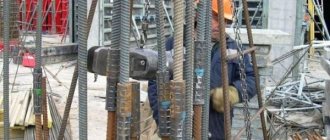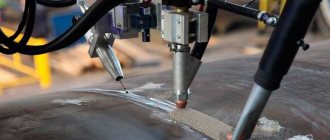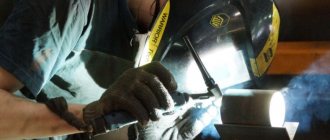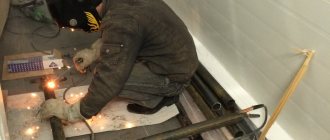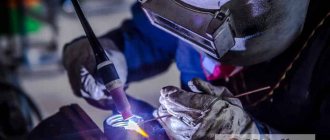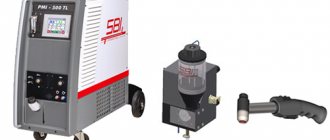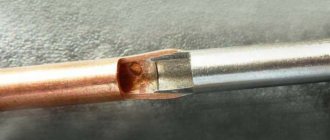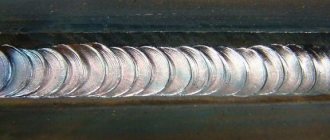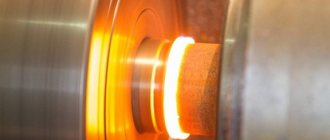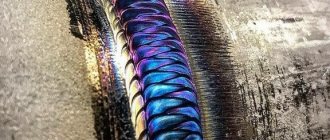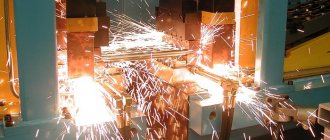Manual arc welding with coated electrodes is an arc welding using coated electrodes, with the welder manually feeding them into the welding zone and moving the arc along the edges being joined. As a result of the melting of the metal edges and the melting of the electrode rod, a weld is formed.
The heating source is an electric discharge (welding arc) between the workpiece and the electrode, which occurs when an electric current passes through an environment filled with air or gas.
The process requires protecting the weld pool from external influences of air gases in order to avoid their penetration into the molten metal, which can lead to deterioration in the quality of the weld. One type of arc zone protection is the use of coated electrodes.
Advantages of the method:
- versatility;
- simplicity;
- possibility of welding in any position in space and hard-to-reach places.
Disadvantages include the dependence of the quality of work on the qualifications of the welder and the low productivity of the process.
Types and characteristics of coated electrodes
The element has the form of a coated metal rod. To coat its surface, a powder from a mixture of different components is used. The technological qualities of the coated electrode depend on the composition of the coating and the quality of its application.
Rods are classified according to several criteria.
By purpose:
- U – for joining carbon and low-alloy steels.
- L – structural steels with alloying additives.
- T – alloyed heat-resistant steels.
- B – high-alloy steels with specific properties.
By coating thickness : thin, medium, thick and extra thick.
By type of coverage:
- A – sour;
- B – basic;
- C – cellulose;
- R – rutile.
Sour (A)
Contain:
- ores and materials with a high oxygen content (granite, hematite) - provide slag protection;
- ferroalloys – reduce iron from oxides and remove oxygen;
- organic impurities (dextrin, starch) – gas protection.
Welding with such electrodes can be carried out in all positions with constant and variable power sources.
Not suitable for cramped conditions.
Basic (B)
The composition of the coating includes:
- ferroalloys;
- calcium fluoride compounds.
Purpose – welding in any position with direct current. The use of alternating current requires the addition of stabilizers to the coating.
Basic electrodes are used for welding critical structures made of alloy and low-carbon steels and parts with large cross-sections.
Cellulose coated (C)
Contain:
- oxycellulose;
- ferroalloys;
- rutile.
The electrodes are suitable for DC welding in any spatial arrangement.
They are often used to connect pipeline joints.
Rutile (R)
Includes:
- rutile concentrate (titanium oxide);
- calcium carbonates (muscovite, marble, talc, magnesite, cellulose, ferroalloys).
Electrodes are used to connect low-carbon steels with alternating and direct current in any location in space.
Classification of coating components
By type of gases formed
- Ionizing.
- Protective.
By type of slag
- Alloying.
- Refining.
- Deoxidizers.
- Protective, creating a “crust”.
Depending on the type of electrodes, slags can also be plasticizing and binding.
There are several types of welding - direct current, pulsed (m/h), alternating. When voltage is applied, it follows the “electrode – workpiece” circuit, but only at the moment of contact with the part. This leads to the formation of an arc. In the high temperature zone (up to 6,800 – 7,000 ºС) both the edges of the sample and the rod melt. As a result of further crystallization of metals, which occurs when it decreases (as the electrode moves along the intended line), a seam is obtained.
In manual mode, welding is carried out with alternating or direct current. Professionals prefer the latter option, with direct polarity. As a result, the electrode remains cold, but the metal in the working area heats up.
What to consider? For different types of welding, different electrodes are used for “=” or “~” current.
Conditions for high-quality arc welding
- Dry sections of samples and electrode.
- Uninterrupted power supply.
- Integrity of grounding conductor insulation. Its defects often cause damage to the seam, “sticking” of the electrode in the working area due to “leakage” of current.
Necessary equipment
- Balanced rheostat. With its help, by changing the current strength, you can perform not only welding work, but also a number of others - cutting, surfacing, tightening.
- Grounding cable. It is an element of an electrical circuit and forms a closed circuit through which current flows.
- "Derzhak."
Necessary equipment
The method requires:
- Power source (welding transformer).
- Voltage limiter.
- Welding cable.
- Ballast rheostat.
- Desktop.
- Electrode holder.
- Launch equipment.
- Welding and assembly equipment.
In addition to the basic equipment, you need: light filters, shields and helmets, clothing and welding tools.
Technique for forming a weld seam
The process of ignition (excitation) of the welding arc must be preceded by the installation of a given welding current - its value is determined by the brand of the electrode, the spatial position of the seam, and the type of welded joint.
Ignition can be carried out according to two schemes:
- The electrode is placed perpendicular to the surface to be welded, a light (without force) touch is applied to the welding site, after which the electrode is raised up, approximately 25 cm.
- Ignition of the arc in the second way is similar to lighting a regular match.
After the arc breaks, it is re-ignited in front of the crater - from the base metal to the deposited metal - this ensures the removal of contaminants accumulating in the recess by lifting them to the surface. Then welding is carried out in the required direction.
The choice of arc ignition method depends on two factors - welding conditions and the experience of the welder.
Welding technology
According to their position in space, seams are of the following types:
- lower;
- vertical;
- ceiling;
- horizontal.
They differ from each other in the angles at which the surface of the welded element is located. The quality of seam formation depends on the angle of inclination of the electrode to the welding direction and the product being welded.
Bottom seams
The butt weld, performed in the lower position, is of high quality. The technology for its implementation is simple.
In order for the welder to clearly see the joint area, it is recommended to apply the bead towards you or from left to right. The width of the roller corresponding to 3-4 electrode diameters is considered normal.
Single-pass welding with a v-shaped edge groove is carried out by transverse oscillation of the electrode over the full width . The arc must move from the bevel of the edges to the area of the untreated metal plane. The difficulty may lie in ensuring uniform welding of the seam along the entire length. Welding such a seam in several passes better ensures penetration of the first layer.
Seams with x- or u-shaped edges are made in the same way . The difference is that each subsequent seam is applied towards the previous one. Bottom butt joint welding is preferably done on a removable copper or steel backing. At the turning points, the seam is welded without breaking the arc.
The corner connection in the lower position is performed using the “symmetrical” or “asymmetrical boat” methods . To perform the work efficiently, welding is carried out using a rod with the visor resting on the edges. When making a corner connection with an inclined electrode, it is recommended to use the “back angle” technique.
The connection without bevel of the edges is made in one layer by transverse movements of the rod in a “triangle”. The fillet weld of an overlap joint is made in one layer using an electrode with a diameter of up to 5 mm.
Vertical
The technique for forming butt and fillet welds is from bottom to top. First, a metal horizontal platform is created, the cross-section of which is equal to the cross-section of the seam material. Electrode movements are transverse, in a triangle. When welding the root of the weld, it is recommended to delay the burning of the arc. The greatest penetration of the root is achieved when the rod is perpendicular to the vertical axis.
Welding using large-diameter electrodes and high current values is difficult due to metal dripping and poor weld formation. In this regard, electrodes up to 4-5 mm in diameter are used. The welding current is reduced by 10% compared to bottom welding.
Vertical welding in the top-down direction is performed with electrodes that produce a thin layer of slag (cellulose, organic plastic coatings).
Ceiling
Due to the possible leakage of liquid metal from the bath, welding ceiling seams is labor-intensive. For this reason, work is performed with a short arc. Characteristic points of ceiling welding:
- 15-20% reduction in welding current compared to the lower position;
- for welding metal with a thickness of 8 mm or more, multi-pass welds are used;
- the diameter of the electrodes is 3-4 mm;
- it is possible to use the method based on the coating of the rod.
Welding of rotary pipe joints
When welding on rotators, select the pipe rotation speed (Vwr) equal to the welding speed (Vw). The welding position most convenient for forming a seam is not at the zenith, but at a point 30-35° from the vertical in the direction opposite to the direction of rotation of the pipe.
When there are no rotators or they are impractical, the welded pipe joints are turned at angles of 60-110°. This allows you to form the seam in the most convenient position - bottom.
Pipes with a diameter of more than 219 mm are welded using a reverse-step method in two full turns:
Pipes rotated 180° are welded in three steps. First, the GL and VL sections are welded in one or two layers. After this, the pipe is turned 180° and the sections of the VB and GB are welded to the full thickness.
Then the pipe is turned 180° and the remaining groove is welded in the HA and VL sections. Welding pipes with a 180° rotation can be performed by one or two welders.
Welding of pipe joints with a 90° turn is also carried out in three steps. First, weld the AVB joint area, laying one or two layers. Then the pipe is turned 90° and the entire thickness of the AGB section is welded. Finally, a reverse turn by 90° follows and welding of the remaining thickness of the pipe in the AVB section.
Welding with a joint rotation allows you to form a high-quality seam with minimal deformations and stresses, a smooth transition to the base metal, with minimal scaliness without sagging or undercuts.
Modes
A beginner has a question: what electrode should be used to weld 2 mm metal? A maximum of three, optimally – not to exceed the thickness of the metal. We won’t find a rod thinner than Ø 1.6 mm; all that remains is to adjust the welding current to the optimum.
Important! drying and calcination of steel electrodes is mandatory.
Welding mode – a combination of the sum of parameters:
- Arc current and voltage;
- Diameter and speed of movement of the electrode;
- Polarity, type of current;
- The position of the seam in space.
Practice shows that it is advisable to use the maximum permissible current, and the speed determines the cross-section of the seam . The arc is ignited in 2 ways: by a short touch with a tear off (butt-to-end) or by a longitudinal movement along the workpiece (with a match).
Vertical and ceiling seams are carried out with current correction down to 20%, voltage - up to 30 V, electrode diameter does not exceed 4 mm. Under standard conditions, the penetration depth reaches 1 – 2 mm.
Maintaining the arc at a distance of 0.5 - 1 diameter to the crater funnel is ensured by the uniform supply of the consumable fuse element. Increasing the arc length increases the flow of air into the melt, reducing quality. Metal waste and spattering increase.
Interruption of the arc is fraught with the formation of a crater where slag accumulates, and cracks may form. The crater is welded until it is filled. The reason for the formation of a crater cannot be the completion of the seam - this is a defect.
Extended seams are made in separate sections. On thick metal, where there is no risk of warping, the passage length is 200 - 300 mm. On thin sheet - short in a checkerboard pattern.
How to strike an arc for an RDS
Scheme of manual arc welding with a consumable electrode.
If you need to start a welding arc that will pass between your electrode and the surface, then you just need to attach the end of the electrode to the metal in a vertical position.
In fact, immediately after touching, you need to start slowly moving the electrode upward, because otherwise you may not get a welding arc, but sticking.
The arc is conducted in such a way that maximum melting of the edges is ensured and the desired quality of metal is obtained.
This can be achieved by maintaining a constant path length, in addition, electrode movement plays a significant role.
Making welds
The length of the seams provides the following classification:
- long (over 1 m);
- medium (0.35-1 m);
- short (0.25-0.3 m).
The section size determines the division of seams into single-pass or single-layer, as well as multi-pass or multi-layer.
The advantage of single-pass welding is efficiency and productivity. Disadvantage: insufficient ductility of the weld metal due to its rough columnar structure and too large overheating zone.
When multilayer welding, each underlying bead undergoes preliminary heat treatment before applying the next bead - this creates a crushed structure of the seam and joint material.
Multilayer welding involves three options for the arrangement of layers:
- sequential application of layers along the length of the seam;
- "cascade" method;
- “slide” overlay.
The last two methods are used when welding metal products with a thickness of more than 25 mm. The execution of multi-layer seams should be accompanied by increased attention to the creation of the first layer created at the root of the seam. The further strength of the entire seam depends on the penetration of the latter.
